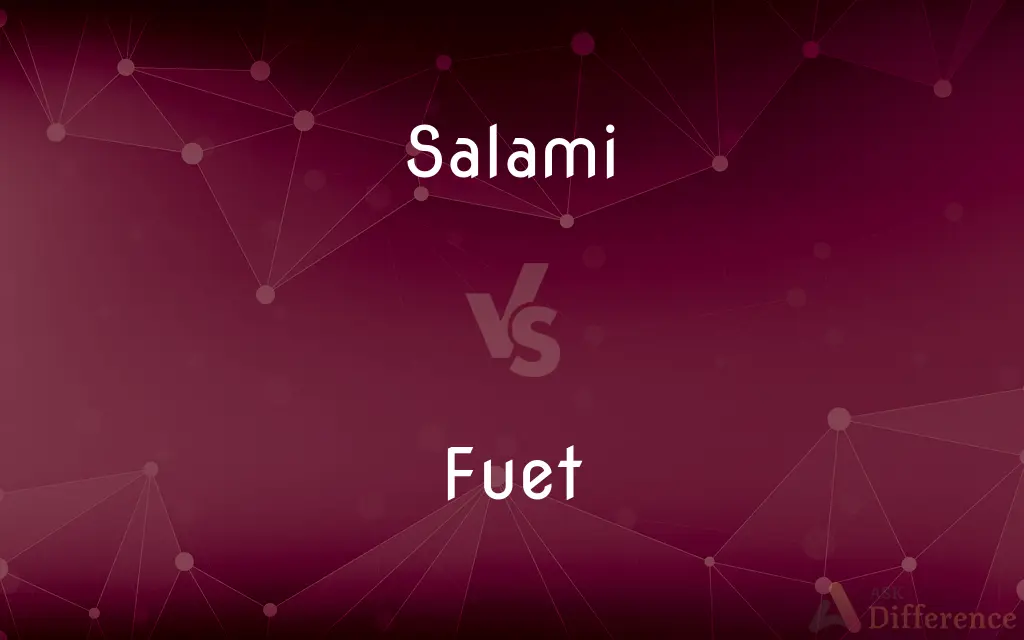Salami vs. Fuet — What's the Difference?
By Fiza Rafique & Urooj Arif — Updated on April 23, 2024
Salami is a versatile, cured sausage known for its rich flavor and firm texture, while fuet is a thinner, Catalan sausage, noted for its mild taste and softer consistency.

Difference Between Salami and Fuet
Table of Contents
ADVERTISEMENT
Key Differences
Salami, originating from Italy, is made from a mixture of seasoned meat, traditionally pork, beef, or a combination, which is then fermented and air-dried. On the other hand, fuet, hailing from Catalonia, Spain, is primarily made from pork and tends to have a milder seasoning compared to salami.
While salami is typically coarser with a pronounced flavor due to the inclusion of garlic, peppercorns, and sometimes wine, fuet is characterized by its smoother texture and a subtler flavor profile, often seasoned just with garlic and pepper.
The drying process of salami can take anywhere from several weeks to months, contributing to its robust flavor and dense texture. Conversely, fuet is usually thinner and cured for a shorter period, which gives it a softer, more delicate texture.
Salami is available in many varieties, each with distinct characteristics based on region and ingredients, such as Genoa salami with its garlic and peppery notes, or soppressata with its hot and spicy flavor. Fuet, however, is typically uniform in its mild taste and finer texture, making it a popular choice for a less intense cured meat experience.
Salami is often enjoyed in slices as part of charcuterie boards, sandwiches, and even cooked dishes, while fuet is commonly served thinly sliced as an appetizer or snack, highlighting its mild yet savory flavor.
ADVERTISEMENT
Comparison Chart
Origin
Italy
Catalonia, Spain
Meat
Pork, beef, or mix
Primarily pork
Flavor
Robust, varies by type
Mild, subtle
Texture
Coarse, firm
Smoother, softer
Curing Time
Several weeks to months
Shorter period
Compare with Definitions
Salami
Often includes a mix of spices, including garlic, peppercorns, and sometimes wine.
This salami has a distinctive taste thanks to the red wine used in its seasoning.
Fuet
Characterized by a finer texture than many other cured sausages.
The fuet was so tender, it almost melted in the mouth.
Salami
A type of cured sausage consisting of fermented and air-dried meat.
He sliced the salami thinly for the pizza topping.
Fuet
A thin, dry-cured sausage from Catalonia, known for its mild flavor.
They served slices of fuet with cheese and olives at the party.
Salami
Commonly eaten sliced in sandwiches, as part of appetizers, or used in cooking.
She added chopped salami to the pasta sauce for extra flavor.
Fuet
Primarily made from pork and seasoned lightly, typically with just salt, pepper, and garlic.
The subtle garlic flavor of the fuet made it a favorite among the guests.
Salami
Known for its rich, complex flavor and dense texture.
The salami added a savory depth to the charcuterie board.
Fuet
Typically cured for a shorter period than other dried sausages.
Fuet is ready to eat quicker than many other traditional sausages due to its thin size.
Salami
Available in various regional varieties with different seasoning and preparation methods.
On their trip to Italy, they tried several types of local salami.
Fuet
Often enjoyed as a snack or appetizer, sliced thinly.
Thin slices of fuet are perfect for a light snack before dinner.
Salami
(baseball) A grand slam.
Fuet
Fuet (Catalan pronunciation: [fuˈɛt], lit. "whip") is a Catalan thin, dry-cured, sausage of pork meat in a pork gut.
Salami
Salami ( sə-LAH-mee) is a cured sausage consisting of fermented and air-dried meat, typically pork. Historically, salami was popular among Southern, Eastern, and Central European peasants because it can be stored at room temperature for up to 40 days once cut, supplementing a potentially meager or inconsistent supply of fresh meat.
Fuet
A type of thin salami from Catalonia made from pork.
Salami
Any of various highly spiced and salted sausages, made from beef or a mixture of pork and beef.
Salami
A large cured meat sausage of Italian origin, served in slices.
Salami
(slang) A penis.
Salami
Highly seasoned fatty sausage of pork and beef usually dried
Common Curiosities
What main spices are used in salami?
Salami often includes garlic, peppercorns, and sometimes spices like fennel or wine.
Is fuet spicy like some salamis?
No, fuet is generally milder with basic seasonings like salt, pepper, and garlic.
What is the typical size of a fuet sausage?
Fuet is usually thinner than many sausages, about the diameter of a chorizo.
Can salami be eaten raw?
Yes, salami is safe to eat raw as it is cured and fermented.
How should salami be stored?
Salami should be stored in a cool, dry place and can be kept in the refrigerator once cut.
Can fuet be used in cooking?
While typically eaten raw, fuet can be used in cooking, adding flavor to dishes like scrambled eggs or pizzas.
What makes salami different from other cured meats?
Salami's unique flavors come from its fermentation process and the variety of spices used.
How long does fuet need to cure?
Fuet typically cures for a few weeks, less than many types of salami due to its thinner size.
What is the best way to serve fuet?
Fuet is best served thinly sliced, at room temperature to enhance its flavors.
Is fuet considered a healthy food?
Like many processed meats, fuet should be consumed in moderation due to its fat and salt content.
What are the nutritional differences between salami and fuet?
Nutritional content can vary, but both are high in protein and fat, with salami often having a higher spice and salt content.
What are some dishes that include salami?
Salami is used in dishes like pizza, pasta sauces, and layered in sandwiches.
Can fuet be frozen for storage?
Yes, fuet can be frozen, although it is best enjoyed fresh to maintain its optimal texture and flavor.
Does the flavor of salami vary by region?
Yes, the flavor of salami can vary significantly based on regional recipes and curing methods.
Are there vegetarian alternatives to fuet?
Yes, there are vegetarian sausages that mimic the texture and flavor of traditional meats like fuet.
Share Your Discovery

Previous Comparison
Tenure vs. Term
Next Comparison
Commune vs. CommunityAuthor Spotlight
Written by
Fiza RafiqueFiza Rafique is a skilled content writer at AskDifference.com, where she meticulously refines and enhances written pieces. Drawing from her vast editorial expertise, Fiza ensures clarity, accuracy, and precision in every article. Passionate about language, she continually seeks to elevate the quality of content for readers worldwide.
Co-written by
Urooj ArifUrooj is a skilled content writer at Ask Difference, known for her exceptional ability to simplify complex topics into engaging and informative content. With a passion for research and a flair for clear, concise writing, she consistently delivers articles that resonate with our diverse audience.
















































